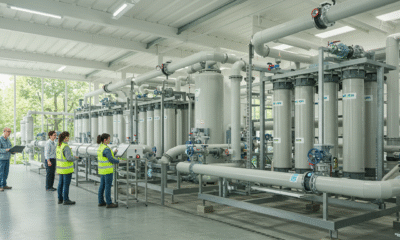

Features
Sustainability in the Defense Sector: Initiatives & Technologies
Traditionally known for its heavy resource consumption, the defense industry faces a pivotal shift toward sustainability. It is one of the industries that is taking steps to be more sustainable in 2024.
The United States military alone is a significant contributor to climate change. This sector is consistently enlarging the carbon footprint the planet has been suffering. They consume liquid fuels that emit more carbon dioxide than most countries and heavily rely on a global network of operations involving bombs and hydrocarbon fuels.
However, the growing awareness has sparked a push towards more sustainable operations. Although balancing national security and environmental protection is complex, many initiatives and technologies have been developed to establish strategic operations without harming the environment.
Sustainability Issues Within the Defense Industry
The impacts of military operations happen before, during, and after conflicts.
Before wars:
Militaries require large land and seas for bases, facilities, training, and testing. Most of the time, these locations are ecologically significant areas. The training and testing often disrupt landscapes and habitats and create noise and chemical pollution from weapons and vehicles.
During wars and occupations:
Some armed conflicts and occupations are brief but highly destructive, while others are lasting with low intensity. However, many contemporary wars are sustained for long periods with high-intensity warfare. Using explosive weapons releases vast amounts of rubble and debris, resulting in air, soil, and water pollution.
After wars:
Most damage during conflicts extends after the warfare. This insecurity often means environmental governance is absent. The quantities of rubble and debris left can create new environmental risks through informal dumping and disposal.
Here are the significant issues associated with these phases:
Energy-intensive consumption
The defense industry’s energy-intensive consumption primarily relies on fossil fuels like oil, contributing to its carbon footprint. This consumption is linked to military vessels, vehicles, aircraft, buildings, and infrastructure during training, testing, and warfare.
As such, this reliance on non-renewable energy resources underscores the pressing need to shift to alternatives to mitigate environmental impacts, improve operational resilience, and reduce long-term consumption costs.
Military-grade equipment production
Military operations and defense businesses aim to produce cutting-edge technologies for national security. This pursuit typically involves using and producing resources with significant environmental repercussions.
Aircraft, tanks, weaponry, body armor, and defense systems contribute to habitat disruptions and carbon emissions, casting more doubt on the industry’s compatibility with sustainability. For these reasons, waste management in military operations has become a significant issue.
Waste management involves ongoing disposal costs. Moreover, the disposal of conventional weapons through detonation or open burning pollutes the air and contaminates the soil. Surplus munitions, or extra ammunition, were even dumped at sea.
Supply chain, high levels of displacement, and the collapse of environmental infrastructure
The defense sector thrives on a vast supply chain involving manufacturing processes from material extraction to equipment assembly.
Many armed groups vie for control over oil and mineral resources. At the same time, processing methods, like the use of mercury in gold mining, can cause water pollution. Private companies may also be active in conflict-affected areas, often with minimal environmental supervision.
Meanwhile, human displacement typically increases carbon footprints due to a lack of essential services like food, water, sanitation, and waste management. Displaced people may transfer their livestock to vulnerable ecosystems, turn to local resources, and swell urban areas, putting resources, ecosystems, and urban services under strain.
High levels of displacement can also reduce waste segregation and increase waste dumping and burning.
The lack of development and investment can even result in the collapse of environmental infrastructure, weakening state control and ecological governance. As such, attention to the environmental aftermath of conflicts is usually limited.
Image by Art Guzman on Pexels
Key Sustainability Initiatives and Technologies
The efforts toward a sustainable defense industry include:
Integration of renewable energy resources
Integrating renewable energy is paramount to the defense sector’s shift toward sustainability. Incorporating solar, wind, and other renewable technologies into military equipment and operations helps reduce the reliance on fossil fuels.
Moreover, many companies have developed advanced energy solutions that enable renewable energy deployment on remote and challenging terrains.
The military-domain-specific initiatives to reduce emissions include:
- Aerospace – Focuses on net zero emissions by using engine and fuel alternatives. In 2021, Safran and General Electric launched aviation technologies that are 20 percent more energy efficient than standard propulsion engines. Additionally, Airbus is developing a hydrogen-powered aircraft for zero emissions by 2035
- Maritime – This domain also prioritizes fuel and propulsion alterations. For example, Leonardo Electronics developed electric and hybrid-electric ship propulsion systems
- Land – Militaries are expected to follow civilians by introducing electric and hybrid vehicles. Some defense companies that engage in the army vehicle electrification market are Oshkosh Corporation and GM Defense LLC
Eco-friendly materials and cleaner manufacturing processes
The assembly of energy-efficient equipment requires eco-friendly resources and clean manufacturing processes. Among the key initiatives was the Defense Production Act (DPA) invocation in the United States, signed by President Joe Biden in June 2022.
This executive order focuses on investing in accelerating domestic production of five energy technologies: solar, transformers and electric grid components, heat pumps, insulation, and electrolyzers.
The increase in the production of these technologies allows the U.S. Department of Energy (DOE) to purchase cleaner materials directly, diminishing the reliance on exploitative overseas supply chains.
Moreover, the U.S. government can extend loans for clean manufacturing to boost energy-efficient equipment production for weapons, body armor like bulletproof vests, and military vehicles.
Internal initiatives
Despite different speeds, most companies have launched internal initiatives to curb their environmental impacts. These methods include replacing carbon manufacturing processes, stricter energy management, and improved waste management.
Some defense contractors have also integrated climate change awareness into their operating models to foster a sense of responsibility. Instilling this eco-conscious culture helps these companies cultivate sustainability in their daily operations and decision-making.
A mindset and culture shift
Achieving a sustainable defense industry goes beyond green initiatives and technological advancements. The shift requires a mind and culture shift through training programs and operational remodeling.
By incorporating sustainability principles in professional development programs, the defense industry can produce a new generation of military leaders and personnel aware of the industry’s social, economic, and environmental impacts. Thus, such programs must focus on critical thinking and long-term environmental stewardship.
Meanwhile, the culture shift must focus on redefining success within the industry. Rather than short-term gains, the sector should adopt a broader outlook that values sustainability by revising policies and procurement practices.
Engaging stakeholders, such as governments, environmental non-governmental organizations, academia, and local communities, is also essential. This collaboration helps establish a collective commitment to creating a more sustainable defense industry.
The Path Towards Sustainability Requires a Holistic Approach
Establishing a sustainable defense industry isn’t linear—it requires a holistic approach. Companies, contractors, governments, and militaries must clearly understand their current emissions to define their targets and strategic roadmaps. This way, we can make meaningful progress toward a more sustainable national and international security.


 Environment10 months ago
Environment10 months agoAre Polymer Banknotes: an Eco-Friendly Trend or a Groundswell?

 Environment11 months ago
Environment11 months agoEco-Friendly Home Improvements: Top 7 Upgrades for 2025

 Features9 months ago
Features9 months agoEco-Friendly Cryptocurrencies: Sustainable Investment Choices

 Features10 months ago
Features10 months agoEco-Friendly Crypto Traders Must Find the Right Exchange





























